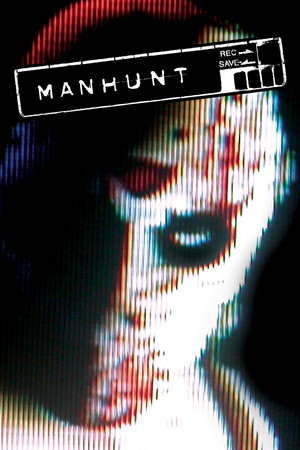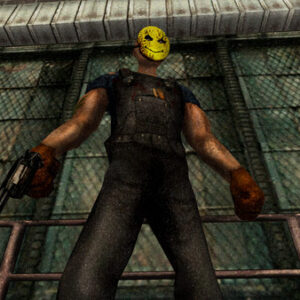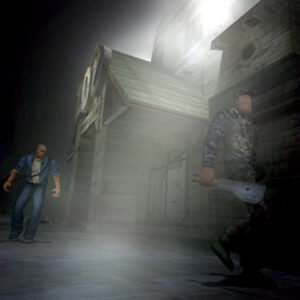Manhunt Free Download Direct Stea-Cracked
They just killed James Earl Cash. Now, they want to kill him again.
In the shadowy, decaying landscape of Carcer City, where urban decay meets total lawlessness, a terrifying game of life and death unfolds. Welcome to the world of Manhunt, a stealth-action horror game developed by Rockstar North and published by Rockstar Games. Originally released in 2003 for the PlayStation 2 and later ported to Xbox and PC, Manhunt carved a unique and bloody path through the gaming landscape that few titles have dared to walk.
Game Overview
- Title: Manhunt
- Developer: Rockstar North
- Publisher: Rockstar Games
- Release Date: November 18, 2003
- Genre: Stealth, Action, Horror
- Platforms: PlayStation 2, Xbox, Windows PC
- ESRB Rating: M for Mature (Blood and Gore, Intense Violence, Strong Language)
A Brutal Premise: The Storyline of Manhunt
You play as James Earl Cash, a death row inmate who regains consciousness in a darkened room, only to find out his execution was faked. In a chilling twist, Cash discovers that he’s now the unwilling star of a series of snuff films orchestrated by a shadowy figure known as The Director, later revealed to be Lionel Starkweather, a former film producer turned psychotic voyeur.
Each level, or “scene,” places Cash in increasingly dangerous environments filled with murderous gangs. The goal? Survive. Hide in the shadows. Take down enemies silently. And always, always keep moving.
The narrative of Manhunt is intentionally bleak and deeply disturbing, but also engaging. It invites players to consider their own role in the violence: are you the victim, the survivor, or the real monster?
As the game progresses, the psychological toll on Cash—and perhaps on the player—becomes more apparent. While the story may seem straightforward on the surface, there are layered implications about manipulation, the illusion of choice, and societal breakdown.
Gameplay Mechanics: Stealth Over Strength
At its core, Manhunt is a stealth game with brutal execution mechanics. Here’s how it works:
- Shadow-Based Stealth: Staying hidden in the shadows is key. The game rewards patience and cunning over brute force.
- Execution System: Players can sneak up on enemies and perform one of three increasingly violent executions depending on how long they hold the attack button. Weapons range from plastic bags and shards of glass to crowbars and machetes.
- Audio Cues and Sound Design: Sound plays a huge role in gameplay. Enemies respond to noise, so players must be careful about sprinting or knocking over objects.
- Environmental Awareness: Use the environment to your advantage. Lure enemies with sounds, hide behind objects, and plan your attacks methodically.
- Gang AI: Each enemy faction has different behaviors. Some are cautious, others aggressive. Learning their patterns is essential for survival.
Advanced tactics like baiting enemies into traps, using multiple hiding spots, and mastering the timing of executions elevate Manhunt from a simple stealth game to an exercise in strategy and nerves.
The World of Carcer City
Carcer City is not just a backdrop; it’s a character in itself. Inspired by America’s post-industrial urban decline, the city is a dystopian hellscape filled with graffiti-covered walls, abandoned buildings, and blood-stained alleyways.
The level design emphasizes claustrophobia and paranoia, with environments like junkyards, factories, and sewers that feel genuinely unsafe.
Each neighborhood reflects a facet of urban decay—from the crumbling projects to derelict zoos—serving as social commentary on neglect, crime, and marginalization. The city’s layered architecture and environmental storytelling allow attentive players to piece together a history of suffering, violence, and systemic failure.
Gangs and Enemies: Kill or Be Killed
Each level introduces a new gang that poses unique challenges. Some of the most notorious include:
- The Hoods: Street thugs with baseball bats and low-level intelligence.
- The Skins: White supremacists armed with high-powered weapons.
- The Smileys: Psychotic asylum escapees wearing blood-smeared smiley face masks.
- The Innocentz: Degenerate cult members dressed in nun and priest outfits, adding an eerie religious element.
These enemies are not mindless. They react to changes in the environment, use team tactics, and even search hiding spots if they suspect you’re nearby. Each faction has a visual and audio identity that adds depth to their menacing presence.
Later stages introduce militarized enemies and corrupt law enforcement, heightening the stakes and forcing players to evolve their tactics. By the end, stealth becomes not just a choice but a necessity.
Aesthetic Choices: Visuals and Audio
Visuals: Manhunt uses a grainy, VHS-style filter that simulates surveillance footage. This stylistic choice reinforces the idea that you are always being watched—not by a camera, but by the player themselves.
The UI is minimalistic, heightening immersion. Each kill is displayed through an unsettling visual filter, adding to the psychological weight of each act.
Audio: The sound design is brilliant and disturbing. From the unsettling whispers of Starkweather in your headset to the screams of enemies during executions, every sound heightens tension. The ambient soundtrack uses minimalistic industrial tones that reflect the bleak world.
Sound plays a tactical role as well, enabling players to eavesdrop on enemies, lure them, and determine their location based on footsteps or whispers.
A Commentary on Media Violence?
Many critics and scholars have interpreted Manhunt as a meta-commentary on media consumption and voyeurism. By turning the player into an accomplice in Starkweather’s snuff film, the game forces uncomfortable introspection: Why do we enjoy violence in media? Where is the line between entertainment and depravity?
Manhunt holds a mirror to the audience, implicating not just fictional characters but the player, the developer, and the culture that celebrates such transgressive entertainment. In doing so, it becomes a layered critique of our media landscape.
Reception and Controversy
Upon its release, Manhunt was met with both acclaim and outrage:
- Critics praised its immersive atmosphere, innovative mechanics, and dark storytelling.
- Parent groups and governments condemned it for its extreme violence.
- It was banned in multiple countries, including New Zealand, Australia, and Germany.
- In 2004, the game became embroiled in controversy after being allegedly linked to a real-life murder in the UK, though these claims were later disputed.
Despite—or because of—this backlash, Manhunt found an audience that appreciated its raw, unfiltered approach. It won several awards for sound design and innovation, though it remains one of the most censored games of all time.
Manhunt’s Legacy and Cult Following
Despite (or perhaps because of) its controversies, Manhunt has built a dedicated fanbase. It remains one of Rockstar’s most discussed titles and has been the subject of:
- Academic papers on violence in video games
- Fan-made mods and remasters
- Calls for a sequel or remastered edition
Rockstar did release a sequel, Manhunt 2, in 2007, which continued the theme of psychological horror but never quite achieved the cult status of the original.
Today, Manhunt is frequently included in lists of the most disturbing games ever made. Its influence can be seen in newer stealth-horror games like Outlast, Condemned, and The Evil Within, all of which owe a debt to Manhunt’s gritty realism and immersive fear.
SYSTEM REQUIREMENTS
- OS *: Microsoft® Windows® 2000/XP Only
- Processor: 1GHz Intel Pentium III or AMD Athlon processor or equivalent
- Memory: 192 MB RAM
- Graphics: 32 MB 3D card
- DirectX Version: Microsoft DirectX® 8.1
- Hard Drive: 2.3 GB uncompressed free hard disk space
Game Insights
- Genre: Action
- Developer: Rockstar North
- Platform: PC
- Game Size: 1.6 GB
- Released By: Thanks to Elamigos
- Version: Build 252033 | Full Version
- Full PC Games


